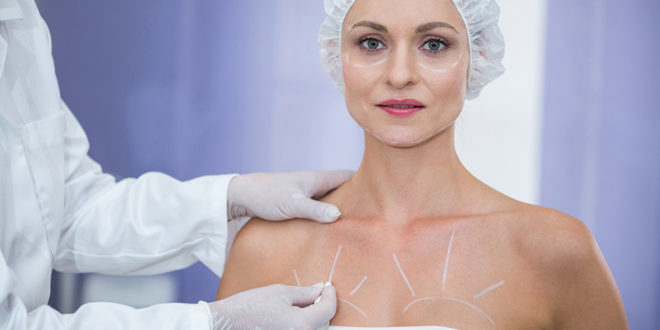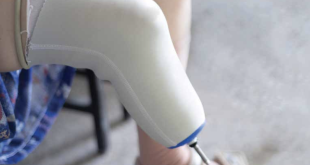 In the early days, and even today, radical mastectomy has been the practiced treatment for diagnosed breast cancer, which means that the entire breast harboring the cancer is removed, along with the underlying muscles and lymph nodes in the axillary region. This not only increased morbidity, but the person had to live the rest of her life with a deformed chest wall. With continuous and profound changes in surgical treatment of breast cancer over the last 30 years, it is seen that the survival rates are similar in both radical mastectomy and breast conserving surgery (BCS) groups. Thus, BCS now has become the gold standard therapy for the treatment of breast cancer.
In the early days, and even today, radical mastectomy has been the practiced treatment for diagnosed breast cancer, which means that the entire breast harboring the cancer is removed, along with the underlying muscles and lymph nodes in the axillary region. This not only increased morbidity, but the person had to live the rest of her life with a deformed chest wall. With continuous and profound changes in surgical treatment of breast cancer over the last 30 years, it is seen that the survival rates are similar in both radical mastectomy and breast conserving surgery (BCS) groups. Thus, BCS now has become the gold standard therapy for the treatment of breast cancer.
The cosmetic appearance of the preserved breast and the rate of local control are the two endpoints that measure the long-term success of breast conserving surgery. Meeting both of these endpoints may be difficult when attempting to resect larger lesions, or when the breast size is smaller. A study done by Cochrane et al. has shown that cosmetic outcome is hugely affected when the ratio of the tumor needed to be resected to the breast volume is more than 10 per cent. The word lumpectomy, or tumorectomy, means excision of the primary tumor, with margins of normal breast tissue less than one centimeter, while quadrantectomy means resection of the quadrant that contains the tumor, with at least two centimeters of normal breast tissue, including the overlying skin and underlying fascia.
Though BCS can be indicated in 70 to 80% of breast cancer cases, it is underutilized, and the reason might be concern of the surgeon and patient of local recurrence, or the probable unpleasant cosmetic outcome, as well as the technical challenges to achieve both of those endpoints. Thus, to overcome this challenge, and to balance the risk of local recurrence of the cancer and the cosmetic outcomes of BCS, a procedure called oncoplastic technique has been introduced. This newly-introduced technique combines the principles of surgical oncology and plastic surgery, and allows removal of larger breast tissue with safer margins without compromising the cosmetic outcome. And, it is less technically demanding and time-consuming, requiring limited training to master it.
The steps to be followed when designing an oncoplastic procedure are:
1. Careful planning of the skin incisions and parenchymal excisions
2. Repositioning of the nipple-areola complex (NAC) to the center of the breast mound, and
3. Correction of the contralateral breast for better symmetry.
Different oncoplastic techniques can be implemented, depending on the location of the tumor within the breast.
Quadrantectomy with round block technique
For a periareolar lesion in a moderate ptosis or hypertrophy breast, the best oncoplastic technique is quadrantectomy with round block technique. The relative contraindications for using this technique are very large, ptotic breast or breasts having lots of additional skin. Skin incision is designed as two circles of different diameters around the nipple, and the skin in-between is resected. Then, quadrant resection of breast parenchyma is performed, with at least two centimeters of macroscopic clear margins on all sides, and includes the pectoralis fascia. Reshaping is achieved by partial dissecting the residual gland.
Central quadrantectomy with skin-glandular flap
For a subareolar breast cancer, and in Paget’s disease, the best oncoplastic technique is central quadrantectomy with skin-glandular flap. In this technique, the entire nipple-areolar complex with underlying cancer, down to the pectoralis fascia, is resected, and a new areola is created with skin-glandular flap from inferior-lateral pole of the residual gland. Excellent oncologic and aesthetic results are achieved, though the breast appears a little smaller than the opposite one.
Quadrantectomy with reduction mastoplasty
A macromastia with cancer located in the lower quadrants, or in superior periareolar region, can best be dealt with using quadrantectomy with reduction mastoplasty. A reduction mastoplasty keyhole pattern incision is used in this technique. This way, the nipple-areolar complex (NAC) is shifted upward to its new position, along with resection of the parenchymal lesion from the skin to the fascia. Depending on the location of the lesion, either in the lower or upper quadrants, a flap to mobilize the NAC is created using a superior or inferior pedicle. The medial and lateral flaps are undermined and sutured together to fill the excision defect, leaving a typical inverted T-scar.
Quadrantectomy with batwing mastopexy
For cancers located deep within or adjacent to the NAC, but not directly infiltrating the major ducts, quadrantectomy with batwing mastopexy is the best technique. Two closely similar half-circle incisions are made with angled wings on each side of the areola, followed by full thickness excision. The defect thus created is closed by the advancement of the fibroglandular tissue.
To improve the cosmetic outcome, repositioning of NAC, or reduction or reshaping of the contralateral breast, may be considered. Excision of tissue from the contralateral breast for improving the symmetry has resulted in a five per cent detection rate of contralateral subclinical cancers, thus the surgeon must use this opportunity to remove any suspicious tissue revealed in a preoperative mammogram.
 Medicosnext
Medicosnext




